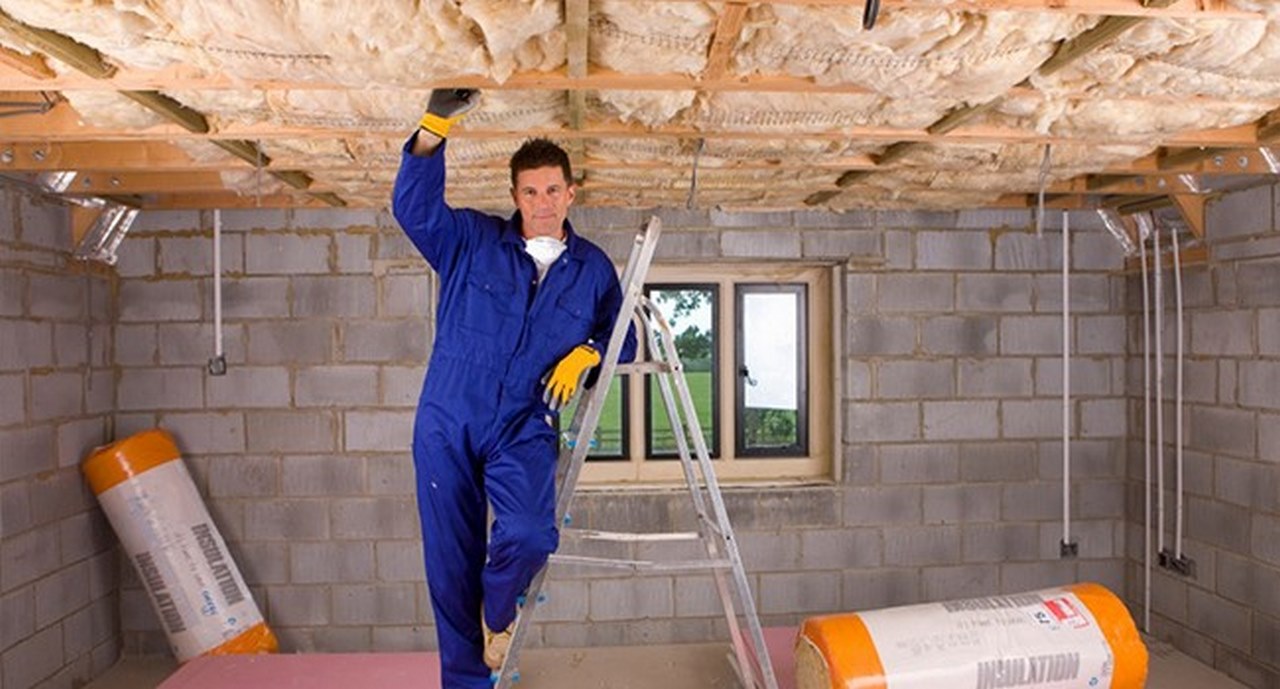The soundproofing basement ceiling is the one that you can do yourself. There are many DIY ways to do this, but one of the most popular is to use fiberglass insulation.
The main goal of fiberglass insulation is to reduce airborne noise transmission. It does this by trapping air in the tiny pockets in the material. This air acts as a buffer, reducing sound traveling through it and into other spaces.

Fiberglass insulation, while not the only soundproofing basement ceiling material out there, is one of the best because it has high energy absorption properties that dampen sounds and vibrations Check Sound proofly to get more articles on fiberglass insulation.
Other types of materials like rubber or wood can also be used to help with soundproofing; however, they are not as effective at stopping noise transfer as fiberglass insulation.
Why Do You Need Soundproofing the Basement Ceiling?
Basements are often used for storage, but because they are built underground, they can be susceptible to moisture. This can lead to mold growth which can cause respiratory problems.
Basement ceilings are also an issue because the ceiling is so close to the ground, it doesn’t have enough airflow.
Moisture from the ground below will accumulate on the basement ceiling and eventually leak through the ceiling boards into the living space above.
Read Also:
How Are Sound Waves Transmitted to And from The Basement?
Soundproofing is an important part of any home improvement project. It is vital to understand the three ways in which sound travels, in and out of the basement, before beginning any DIY soundproofing project.
There are three main ways for noise to travel through your home: airborne (sound waves), conduction (when air molecules transfer sound vibrations), and diffusion (sound waves that bounce off objects).
Airborne Noise
You can hear sound waves traveling through the airwaves, meaning they are any of the noises you normally hear. They travel through doorways, open windows, stairwells, hallways, and other spaces in a building.
Airborne noise can come from a number of sources. These may include conversations, the radio or TV, motorized vehicles, dogs barking, or planes flying in the sky.
Mechanically Transmitted Sound
The noise that an aircraft engine makes when flying overhead can easily pass through walls, ceilings, floors, and roofs in a building. The noise becomes mechanical in nature and can travel through the ground or any other object in its path.
Impact isolation class transmission stands for the classification of transmitted sound depending on the depth from which it is being generated from. For example, a sound generated through a door may be classified as a class I or II types. It’s hard to say exactly where the sound came from.
It could be anything from a dropped item on the floor, to the noise coming from an air-conditioner mounted on an exterior wall, or something striking a wall or other object.
Flanking Noise
Flanking noise, which is sound that travels through indirect paths from one place to another, is a common issue in residential homes and commercial properties.
This means that the sound can travel laterally through a building’s joists or even resonate through ductwork in a building or vibrate through a concrete floor. It can even be heard from behind closed doors & from a distance
Soundproofing for a building should effectively block all three ways of sound traveling through it: air leaks, mechanical vibrations, and airborne sound.
Basics Fundamental of Ceiling Soundproofing
Ceiling soundproofing is a process of reducing the amount of noise that is transmitted from one room to another. The sound will be lessened by either absorbing vibrations or reflecting them back into the room.
How Should We Soundproof the Ceiling?
To soundproof a ceiling, you need to protect the latticework on top of it by adding additional material to block or suppress noise. You also have to interrupt the way mechanical vibrations travel through joists and supports by letting them rest at different levels
The hardest paths to soundproof are those that run along the longest or most indirect path since these directions carry more sound. If you’re planning out this type of soundproofing, look at any interior basement walls, HVAC systems, and plumbing.
Knowing the above will help you choose whether you want to use noise-dampening materials or ones that are specifically
Here Are the Four Main Elements of Soundproofing:
1. Decoupling
The decoupling of different levels in your home can be achieved by creating gaps between the joists and ceiling layers, or other solid surfaces, which will break the sound waves and give you an excellent measure against noise pollution.
2. Adding Mass
Sound vibrations are created by waves that are too small to be seen. Decreasing the ‘mass’ of your walls will make it difficult for noise to travel. However, this is only possible if the materials used are heavy enough to make a difference.
As a general rule, building another layer of drywall 5 inches from the existing wall will only reduce sound transfer by about five decibels. So while this measure may be helpful if your teenager is practicing drums in one room and you want to sleep in the next room, it might not be enough to help with a teenage party that is happening down the hall.
3. Absorbing
A soft pillow might seem to muffle sound coming from thunder, but it doesn’t mean insulation can do the same. In reality, a fuzzy foam or fiber-mounted blanket only offers a level of protection that’s similar to that of passive noise-canceling headphones.
The denser the material, the better it absorbs sound. Vinyl membranes, MDF (medium-density fiberboard), or even drywall all tend to offer slightly better absorption ratings than regular fiberglass. However, adding insulation behind a denser barrier will dramatically improve sound absorption.
4. Damping
A new type of damping compound has been developed that decreases the number of sound vibrations traveling from a surface to a neighboring one. This material can also be used for ceilings and wall studs to prevent sound from traveling around the room.
Acoustic drywall, for example, is a much better option than regular gypsum since it’s more effective at dampening soundwaves.
Sound travels on airwaves, so it’s important to tighten up spaces to ensure sound does not get in or out. Gaps in the spaces between walls, ceilings, floors, and windows can allow sound to penetrate through. Sealing these with acoustic caulking and foam is a good idea.









